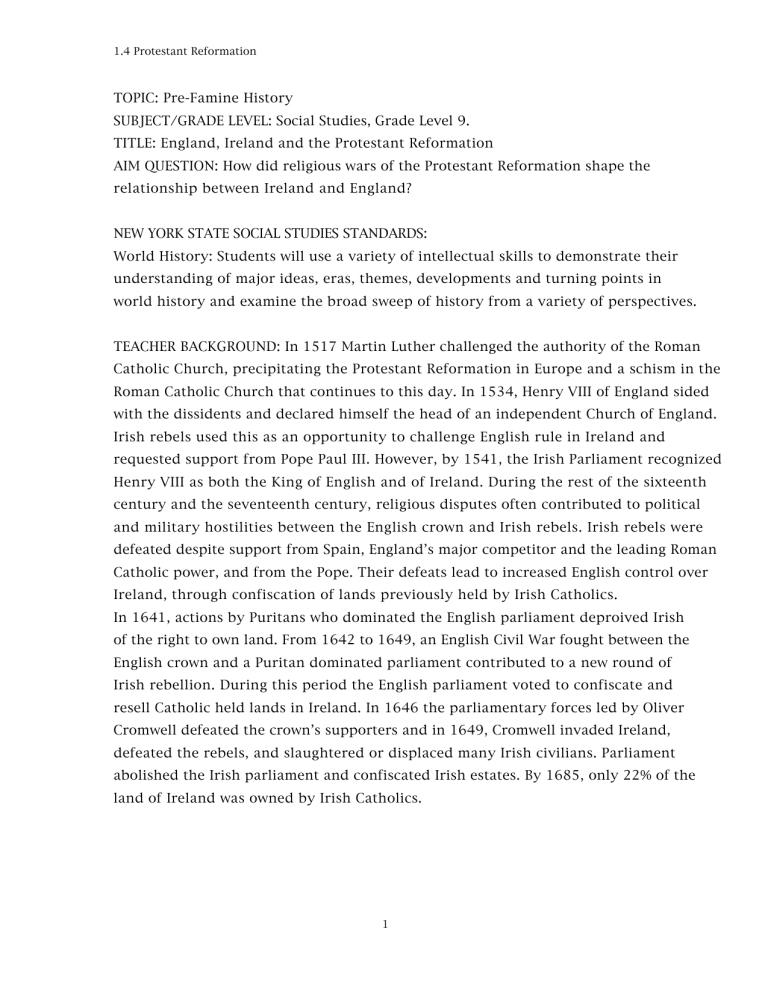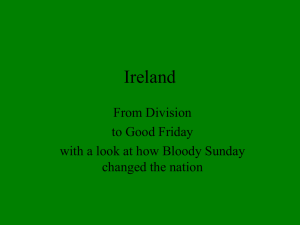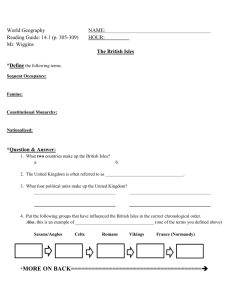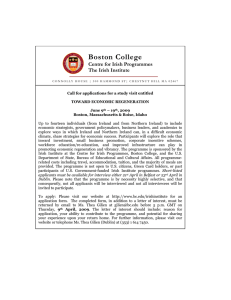TOPIC: Pre-Famine History SUBJECT/GRADE LEVEL: Social Studies, Grade Level 9.

1.4 Protestant Reformation
TOPIC: Pre-Famine History
SUBJECT/GRADE LEVEL: Social Studies, Grade Level 9.
TITLE: England, Ireland and the Protestant Reformation
AIM QUESTION: How did religious wars of the Protestant Reformation shape the relationship between Ireland and England?
NEW YORK STATE SOCIAL STUDIES STANDARDS:
World History: Students will use a variety of intellectual skills to demonstrate their understanding of major ideas, eras, themes, developments and turning points in world history and examine the broad sweep of history from a variety of perspectives.
TEACHER BACKGROUND: In 1517 Martin Luther challenged the authority of the Roman
Catholic Church, precipitating the Protestant Reformation in Europe and a schism in the
Roman Catholic Church that continues to this day. In 1534, Henry VIII of England sided with the dissidents and declared himself the head of an independent Church of England.
Irish rebels used this as an opportunity to challenge English rule in Ireland and requested support from Pope Paul III. However, by 1541, the Irish Parliament recognized
Henry VIII as both the King of English and of Ireland. During the rest of the sixteenth century and the seventeenth century, religious disputes often contributed to political and military hostilities between the English crown and Irish rebels. Irish rebels were defeated despite support from Spain, England’s major competitor and the leading Roman
Catholic power, and from the Pope. Their defeats lead to increased English control over
Ireland, through confiscation of lands previously held by Irish Catholics.
In 1641, actions by Puritans who dominated the English parliament deproived Irish of the right to own land. From 1642 to 1649, an English Civil War fought between the
English crown and a Puritan dominated parliament contributed to a new round of
Irish rebellion. During this period the English parliament voted to confiscate and resell Catholic held lands in Ireland. In 1646 the parliamentary forces led by Oliver
Cromwell defeated the crown’s supporters and in 1649, Cromwell invaded Ireland, defeated the rebels, and slaughtered or displaced many Irish civilians. Parliament abolished the Irish parliament and confiscated Irish estates. By 1685, only 22% of the land of Ireland was owned by Irish Catholics.
1
1.4 Protestant Reformation
AIM: How did religious wars of the Protestant Reformation shape the relationship between Ireland and England?
ASSESSMENT: - Students will demonstrate an understanding of cause and effect in history and the ability to support conclusions based on an evaluation of evidence through individual and group writing assignments and during group and class discussions.
- Students will demonstrate the importance of examining and respecting multiple perspectives on explaining historical events.
- Students will understand historical events based on an analysis of a primary source document.
DO NOW ACTIVITY: Examine the poem “The Gaels in Arms,” written in the 1650s. What is the poet's message?
MOTIVATIONAL ACTIVITY: In the 16th and 17th century, religious conflict between
Catholics and Protestants produced continuing warfare in Europe. It culminated in the Thirty Years’ War that tore apart the remnants of the Holy Roman Empire.
Protestant monarchs supported German Protestants and Catholic monarchs supported
German Catholics. During the war, more than a third of the German population died of war, disease or famine. The war finally ended with the Peace of Westphalia in 1648.
The treaty recognized that in the future, the religion of the ruler would be the official religion of the area.
Would you go to war to have your religion made the national religion? Explain.
Would you fight to protect your right to your religious beliefs? Explain.
TRANSITIONAL ACTIVITY: In your opinion, why did religious differences produce such devastating wars in Europe during the 16th and 17th centuries?
ACTIVITIES: - Read and discuss the poem from the 1650s. Key questions:
In the poem, who are the Gaels? Who are the followers of Calvin and Luther?
What does the poet mean by "True faith shall be uncontrolled"? According to the poet, when will the people "be rightly taught"? Do you think an end to religious war could bring "everlasting peace" to Europe? Explain.
Do you think an end to religious war could bring "everlasting peace" to Ireland and England? Explain.
Do you think victory for one side could bring "everlasting peace"? Explain.
- Examine the Chronology of Religious Warfare. Identify key events.
What is happening in Europe during this period of Irish-English conflict?
Do you think events in Ireland are related to other events in Europe? Key questions:
In your opinion, what other factors fed into this series of religious wars?
2
1.4 Protestant Reformation
In 1649, Oliver Cromwell, an enemy of the Irish, declared that the slaughtering of
Irish troops was "a righteous judgment of God upon those barbarous wretches who have imbrued their hands in so much innocent blood." Do you believe the English actions were justified? Why or why not?
Did these, and other actions by the English, justify Irish revolts? Explain.
Why do you think the Peace of Westphalia in 1648 failed to end the conflict between
Ireland and England?
SUMMARY QUESTION: How did religious wars of the Protestant Reformation shape the relationship between Ireland and England?
HOMEWORK: Find a newspaper article that reports on a contemporary war. Summarize the information from the article. Discuss how this war is similar to or different from wars fought during the Protestant Reformation in Europe.
APPLICATION: In your opinion, how are contemporary wars similar to or different from warfare during the Protestant Reformation?
REFLECTION: Some of the teachers who field tested this lesson used it as an opportunity to place conflict between England and Ireland in the broadest global context. Siobhan Miller who teaches in an ethnically diverse high school in Herricks, New York found that many students were confused by the terms Protestant and Christian and that these had to be discussed. Students who are members of Protestant churches considered themselves members of independent denominations (e.g.,
Lutheran, Methodist, Bapist) and did not immediately understand the historical and theological relationships between these groups.
Protestant students did tend to identify with the broader notion of
Christian but saw Christian as different from (Roman) Catholic. Non-
Christian students, including Jews, Muslims and Hindus, were puzzled by distinctions being drawn between groups and beliefs that they saw as fundamentally similar.
The poem, “The Gaels in Arms,” offers the promise that the rightful kingdom will be restored. Students can compare this poem with the poetry of other colonized people from the preaching of Jesus in the New
Testament to “A Dry White Season” by Mongane Wally Serote in apartheid South Africa.
3
1.4 Protestant Reformation
ACTIVITY SHEET: The religious wars of the Protestant Reformation
DO NOW: Examine this poem written in the 1650s. The Gaels are the Irish, the followers of Calvin and Luther are Protestants, and Eire is another term for ireland. What is the poet's message?
The Gaels in arms shall triumph
Over the crafty, thieving, false sect of Calvin,
Their nobles shall bear sway over unbelievers,
And scatter the brood of Luther.
True faith shall be uncontrolled;
The people shall be rightly taught
By friars, bishops, priests, and clerics,
And everlasting peace shall dwell in Eire.
Source: Thomas Bartlett and Keith Jeffrey, ed. A Military History of Ireland (NY: Cambridge University,
1996)
4
1.4 Protestant Reformation
ACTIVITY: Examine the Chronology of Religious Warfare. Identify key events.
What is happening in Europe during this period of Irish-English conflict?
Do you think events in Ireland are related to other events in Europe? Explain.
Chronology of Religious Warfare, 1519-1685
1519-1521. Henry VIII of England increases taxes in Ireland and strengthens
English control.
1534-1536. England breaks with the Roman Catholic Church. Thomas Fitzgerald,
“Silken Thomas”, the eldest son of the Earl of Kildare leads a rebellion
1537.
against Henry VIII. Requests aid from Pope Paul III.
Rebels are defeated and leaders are executed. Henry VIII declared
"Supreme Head on Earth of the whole Church of Ireland." Supresses monasteries.
1541.
1549.
Henry VIII declares that the King of England is the King of Ireland.
Efforts to impose English Book of Common Prayer on Ireland.
1550-1557.
English settlers replace Irish tenants on “plantations” in Ireland.
1561-1567.
Shane O’Neill rebellion.
1568-1573.
Earls of Desmond lead guerrilla war against England.
1579.
Pope Gregory XIII and Philip II of Spain support a second Desmond
1583.
rebellion. Sir Walter Raleigh executes Spanish and Italian invaders.
Earl of Desmond killed near Tralee.
1595-1603. Rebellion of Hugh O’Neill. O'Donnells and O'Neills lead Irish chieftains
1601.
in Catholic rebellion against England. Hugh O'Neill declared unofficial
Prince of Ireland.
3,500 Spanish soldier land in Cork to support the O'Neill rebellion.
Combined Spanish-Irish force is defeated by Mounjoy.
1602.
1607.
1610.
1641.
Flight of the Earls. Leaders of rebellion flee Ireland. Their lands are seized by the crown.
New English “plantations” are started in Ulster.
Puritans in the English parliament press for end to tolerance of Irish
Catholicism. Scottish and English planters are killed in Ulster uprising.
Protestants in England charge Irish Catholics with atrocities. English parliament votes to confiscate and resell Catholic held lands.
5
1.4 Protestant Reformation
1649.
1652.
1653.
Oliver Cromwell and 12,000 man Puritan New Model Army invade
Ireland. Defenders of captured towns are slaughtered. Rebellion defeated.
Increased English settlement in Ireland leads to land confiscation.
Puritan dominated English parliament abolishes Irish parliament. Irish estates are confiscated. Irish landowners east of the Shannon River face the death penalty or enslavement in the West Indies.
Only 22% of the land of Ireland is owned by Irish Catholics.
1688.
Source: John O"Beirne Ranelagh, A Short History of Ireland (NY: Cambridge University Press, 1983)
6
1.4 Protestant Reformation
Irish - English Conflict in a Global Context, 1519-1685
Years Irish-English Conflict
1519-1521 Henry VIII increases taxes in
Ireland and English control.
1534-1536 England breaks with the Roman Catholic
Church. Irish rebellion against Henry
VIII. Pope Paul III asked for support.
1537 Rebels are defeated and leaders are executed. Henry VIII declared head of the Church of Ireland.
1541
1549
Irish Parliament accepts Henry VIII as
King of Ireland.
Roman Catholic Mass outlawed in
Ireland.
1566-1583 Earls of Desmond lead guerrilla war against England.
1579 Pope Gregory XIII and Philip II of Spain support an Irish rebellion against
England.
Global Context
Martin Luther challenges authority of the Roman
Catholic Church.
Jacques Cartier of France sails to North America.
Hernando de Soto explores Mississippi River valley.
Ivan IV calls first national assembly in Russia.
Akbar the Great conquers China.
Japan opens port of Nagasaki opened to trade.
Founding of Dutch Republic.
Portugal establishes trade base in Bengal.
1583 Earl of Desmond executed.
Lands are confiscated
1593-1603 O'Donnells and O'Neills lead Irish chieftains in Catholic rebellion against
England. Hugh O'Neill declared unofficial Prince of Ireland.
1601
1641
1649
1653
1685
1588- Defeat of Spanish Armada.
1595- War between France and Spain.
3,500 Spanish soldier land in Cork to support the O'Neill rebellion. Combined
Spanish-Irish force is defeated.
Puritans in the English Parliament press for end to tolerance of Irish
Catholicism. Ireland rebels. 12,000
Scottish and English planters are killed in Ulster. Protestants in England charge
Irish Catholics with atrocities. English
Parliament votes to confiscate and resell
Catholic lands.
Plot against Elizabeth I of England fails.
1641-1648- England torn by Civil War. Puritans control English Parliament.
Oliver Cromwell and 12,000 man Puritan New
Model Army invade Ireland. Defenders
Charles I of England is beheaded.
of captured towns are slaughtered.
Rebellion defeated.
Puritan dominated English Parliament abolishes the Irish Parliament. Irish lands are confiscated. Irish landowners east of the Shannon River face death or enslavement in the West Indies.
Oliver Cromwell named Lord Protector of
England.
Only 22% of the land of Ireland is owned by Irish Catholics.
Chinese ports opened to foreign trade.
James II becomes King of England.
Source: John O"Beirne Ranelagh, A Short History of Ireland (NY: Cambridge University Press, 1983)
7








